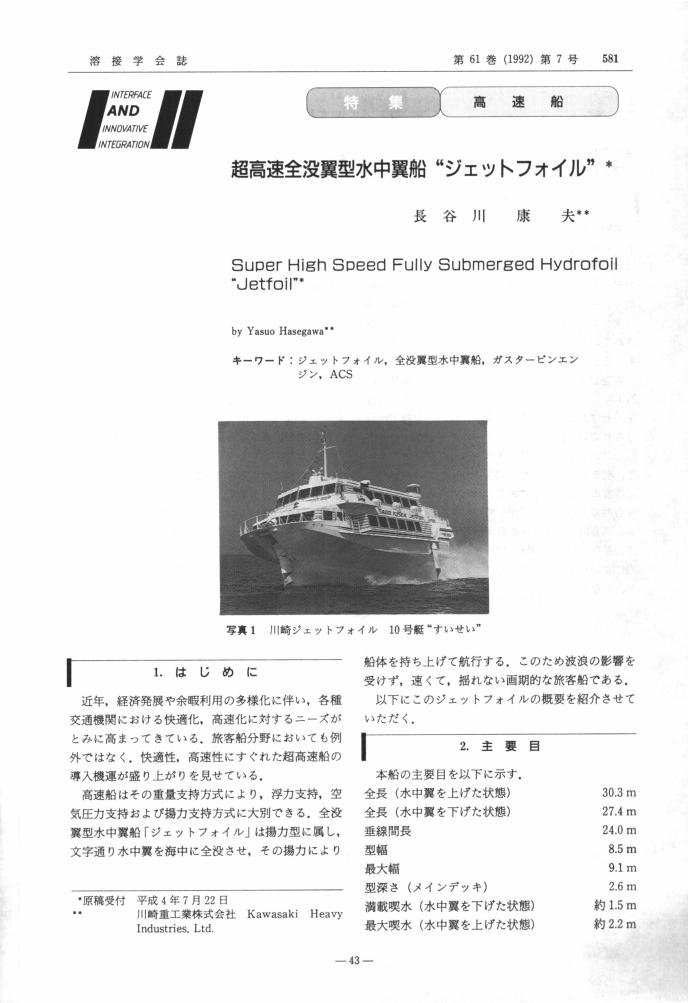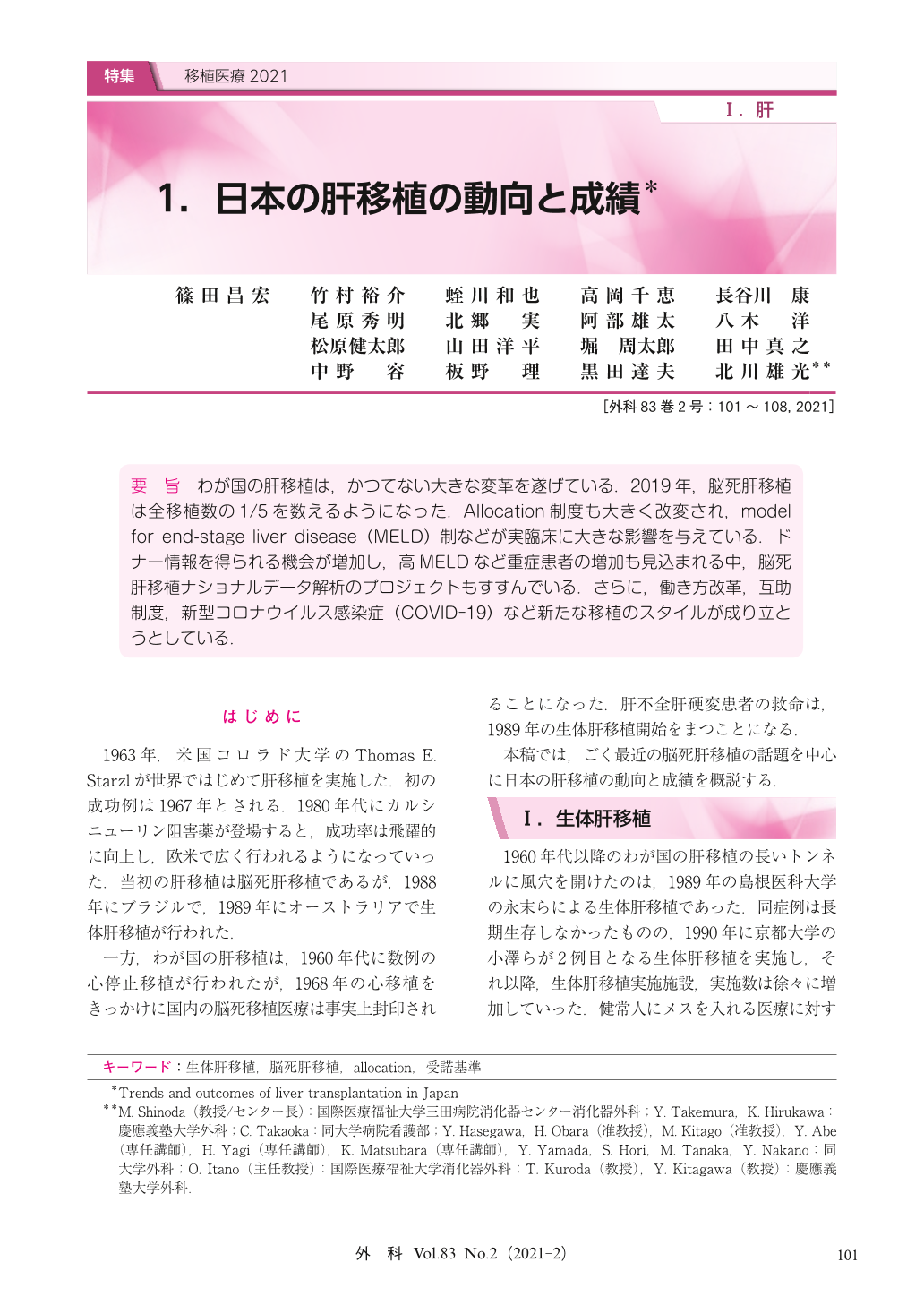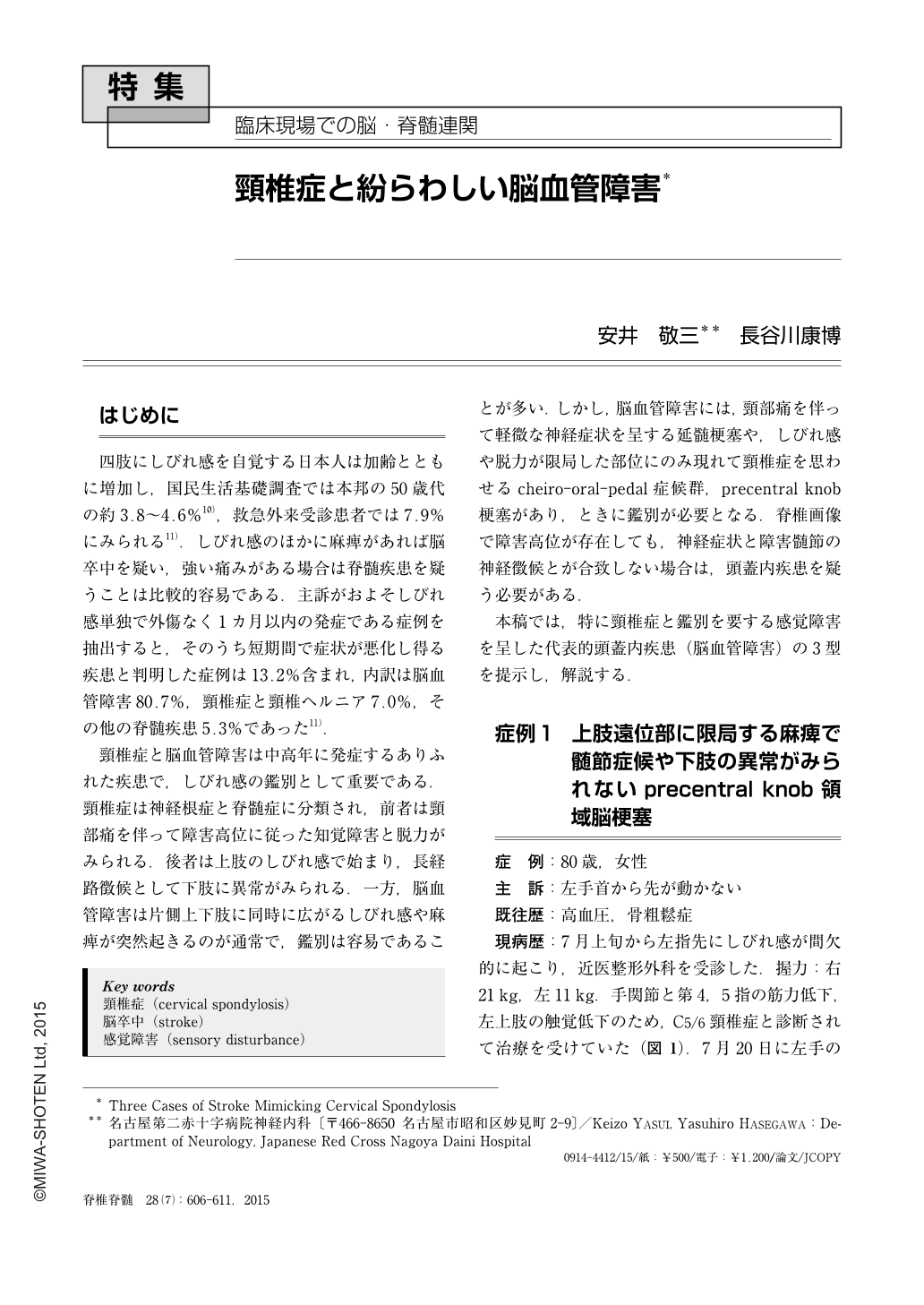- 著者
- 伊藤 大輔 安井 敬三 長谷川 康博 中道 一生 勝野 雅央 髙橋 昭
- 出版者
- 日本神経学会
- 雑誌
- 臨床神経学 (ISSN:0009918X)
- 巻号頁・発行日
- vol.56, no.7, pp.481-485, 2016 (Released:2016-07-28)
- 参考文献数
- 24
- 被引用文献数
- 1 2
症例は65歳の女性である.再発性の小リンパ球性リンパ腫に対し,半年間rituximab等が投与され,めまいと小脳性運動失調が発症した.頭部MRIで両側中小脳脚病変を認め,進行性多巣性白質脳症(progressive multifocal leukoencephalopathy; PML)を疑い,髄液中JC virus(JCV)-DNA PCR検査を数回施行し,4回目に初めてJCV-DNAが検出され,診断が確定した.小脳萎縮を認め,granule cell neuronopathyの合併が示唆された.Mirtazapineとmefloquineの併用治療により長期生存が得られた.PMLでは両側中小脳脚の病変で発症する例がある.また,病初期には髄液検査でJCV-DNAが陰性のことがあり,繰り返し検査する必要がある.
12 0 0 0 OA 重症熱中症急性期にMRI拡散強調像にて小脳皮質の高信号を捉えた1例
- 著者
- 藤岡 祐介 安井 敬三 長谷川 康博 高橋 昭 祖父江 元
- 出版者
- 日本神経学会
- 雑誌
- 臨床神経学 (ISSN:0009918X)
- 巻号頁・発行日
- vol.49, no.10, pp.634-640, 2009 (Released:2009-12-07)
- 参考文献数
- 27
- 被引用文献数
- 9 8
意識障害と痙攣で発症した重症熱中症の47歳,男性症例.意識障害の改善後,高度の無為・無欲,体幹失調等の小脳性運動失調症候がみられた.急性期の頭部MRI拡散強調像(DWI)にて小脳皮質に,ADC値の低下をともなう異常高信号がみられた.発症約2カ月後,体幹失調,構音障害は改善したが,四肢の測定障害はむしろ悪化した.MRI(DWI)上の異常高信号は消失したが,小脳は萎縮傾向を示し,脳血流シンチグラフィでは小脳歯状核部の血流低下が増強した.DWIでの異常高信号は,高体温による小脳Purkinje細胞の細胞性浮腫を捉えた可能性があり,その後の小脳萎縮の出現や後遺症の有無について注意深く検討する必要があることを示している. 本症例では急性期に酒石酸プロチレリンを使用し,無為・無欲に対する有効性を確認した.熱中症後の無為・無欲の改善を期待し試みられるべき治療の一つであると考える.
4 0 0 0 OA 北海道奥尻島南部新第三系の地質と化石珪藻群
- 著者
- 秦 光男 長谷川 康雄
- 出版者
- 地学団体研究会
- 雑誌
- 地球科学 (ISSN:03666611)
- 巻号頁・発行日
- vol.24, no.3, pp.93-103, 1970-05-25 (Released:2017-07-26)
- 被引用文献数
- 3
Up to date the geology and palaeontology of the Okushiri Island off Hokkaido has been studied by some investigators. The writers carried out the geological review and the study of the Tertiary marine diatoms collected from the southern area of this island. The conclusions are as follows: (1) In the geological survey the upper part of the Senjo Formation consisting of siltstone and the Muejitna Formation called by (SUZUKI and SONOKI, 1936) seem to be synchronous and heterofacies to each other. Then these facies were newly unified by one of the writers, Hata, as the Yoneoka Formation. (2) The two samples from the Yoneoka Formation is clearly distinguished by dominant and characteristic diatom species, Coscinodiscus marginatus, Denticula kamtschatica and the genus Thalassiosira (T. antiqua, T. decipiens, T. nidulus, T. oestrupi and T. zabelinae). No combination of species composition of four categories (21 diatom taxa in a random count of 200 marine planktonic species) used by KOIZUMI (1968) for recognition of the diatom zones in Tertiary sediments on the Oga Peninsula, Akita Prefecture, Northeast, Japan, occurs in this formation. The Yoneoka samples may be correlated with the assemblage of the Maido Formation (upper Miocene) of the Ajigasawa district, Aomori Prefecture, Northeast Japan, studied by Koizumi, (1966) corresponding to the Kitaura Formation of the Oga Peninsula. (3) The Tsurikake Formation are characterized with the six extinct species, Denticula nicobarica, Cosmiodiscus intersectus, Synedra jouseana, Thalassiosira cfr. kisselevii, T. usatschevii and Stephanopyxis lineata. This formation is assumed to be represent the lower part of the middle Miocene of this area, according to the palaeontological evidences of the molluscan fauna and the planktonic foraminifers of the Nishikurosawa's type (Gobigerina praebulloides, G. scitula and Sphaeri dinellopsis subdehiscens). (4) The ranges of following species, Denticula kamtschatica, Cosmiodiscus intersectus, Synedra jouseana, Thalassiosira usatschevii and T. zaberinae, reported byJoust (1962) to be restricted to the Pliocene are found to extend into the Miocene in this area, though already their ranges was reported by KOIZUMI (1966) in the Northeast Japan and SHESHUKOVA-PORETZKAYA (1967) in Sakhalin and Kamtshatka of the Far East. The predominant species, Denticula nicobarica, of the Tsurikake Formation also was reported by SIMONSEN and KANAYA (1961) to occur in the uppermost Miocene in California, U.S.A.
3 0 0 0 OA 超高速全没翼型水中翼船"ジェットフォイル"
- 著者
- 長谷川 康夫
- 出版者
- 一般社団法人 溶接学会
- 雑誌
- 溶接学会誌 (ISSN:00214787)
- 巻号頁・発行日
- vol.61, no.7, pp.581-586, 1992-10-05 (Released:2011-08-05)
- 参考文献数
- 4
- 被引用文献数
- 1
- 著者
- 荒木 周 中井 紀嘉 安井 敬三 長谷川 康博 祖父江 元
- 出版者
- 一般社団法人 日本脳卒中学会
- 雑誌
- 脳卒中 (ISSN:09120726)
- 巻号頁・発行日
- vol.34, no.6, pp.421-428, 2012 (Released:2012-11-23)
- 参考文献数
- 15
【目的】急性期の一過性脳虚血発作(TIA)の患者におけるMRI FLAIR像でのhyperintense vessel sign(HVS)の頻度とその患者群の臨床的特徴について明らかにする.【方法】神経学的局在所見が発症後24時間以内に消失した165例を対象にHVSの有無を後方視的に調査した.HVSの有無で2群に分けて臨床像・検査の諸項目を比較検討した.【結果】HVSは対象の9.7%に認めた.HVS群は50%以上の主幹動脈狭窄を合併し,TOAST分類でlarge vessel typeと推定できるものが多かった.ABCD2スコアや拡散強調像での脳梗塞の有無とは無関係であった.HVS群の94%でHVSを呈した動脈と神経症候が合致した.HVS群の80%で平均60日後にHVSの消失を確認した.【結論】急性期TIAでのHVSは虚血の存在を客観的に示す画像所見として診断の上で有用と考える.
2 0 0 0 超高速全没翼型水中翼船"ジェットフォイル"(<特集>高速船)
- 著者
- 長谷川 康夫
- 出版者
- 社団法人溶接学会
- 雑誌
- 溶接学会誌 (ISSN:00214787)
- 巻号頁・発行日
- vol.61, no.7, pp.581-586, 1992-10-05
2 0 0 0 OA 食品からのアルミニウムの一日摂取量の推定
- 著者
- 松田 りえ子 佐々木 久美子 酒井 洋 青柳 由美子 佐伯 政信 長谷川 康行 日高 利夫 石井 敬子 望月 恵美子 山本 敬男 宮部 正樹 田村 征男 堀 伸二郎 池辺 克彦 辻 元宏 小嶋 美穂子 佐伯 清子 松岡 幸恵 西岡 千鶴 藤田 久雄 城間 博正 大城 善昇 豊田 正武
- 出版者
- 公益社団法人 日本食品衛生学会
- 雑誌
- 食品衛生学雑誌 (ISSN:00156426)
- 巻号頁・発行日
- vol.42, no.1, pp.18-23, 2001-02-25 (Released:2008-01-11)
- 参考文献数
- 7
- 被引用文献数
- 8 7
1996年から1998年に, トータルダイエット試料中のアルミニウム濃度を測定しアルミニウムの一日摂取量を推定した. 10か所の機関でトータルダイエット試料の調製及びアルミニウム濃度の測定を行った. アルミニウムの一日摂取量は平均3.5mgであり, 範囲は1.8mgから8.4mgであった. 分析結果の正当性は, 認証標準試料の分析により保証された.
2 0 0 0 OA 旭川市における障害者の乗馬 : 旭川アルム作業所の乗馬活動を通して障害者は何を得たか
- 著者
- 長谷川 康弘 桝澤 美紀 桝澤 良和 小野寺 由香 古川 宇一
- 出版者
- 北海道教育大学
- 雑誌
- 情緒障害教育研究紀要 (ISSN:0287914X)
- 巻号頁・発行日
- vol.18, pp.183-194, 1999-02-10
- 被引用文献数
- 2
本報告は,旭川市にある障害者地域共同作業所において,通所者の作業の一環として取り入れている乗馬活動を通して障害者は何を得たかを述べたものである。障害者の乗馬は,馬,障害を持つ乗り手,そして両者を理解する介助者の三者が揃って活動されるものである。特に障害児者を乗せる馬からは生きものと運動していることを馬の表情や動きから感じ取ることができ,馬にまたがる障害児者からは表情が生き生きとした笑顔に変わったり鼻歌が出たりといった心理的な変化を観察できた。また動物が苦手な障害児者が馬には触れることができたり,馬がきっかけで他の動物に興味を持ったりしている。そして馬の存在が障害のあるなしにかかわらずあらゆる人の交流のきっかけも作っている。
1 0 0 0 OA 鉄道技術研究所の紹介
- 著者
- 長谷川 康
- 出版者
- 社団法人 日本伝熱学会
- 雑誌
- 伝熱研究 (ISSN:09107851)
- 巻号頁・発行日
- vol.3, no.9, pp.29-31, 1964-03-31 (Released:2010-12-16)
1 0 0 0 1.日本の肝移植の動向と成績
- 著者
- 篠田 昌宏 竹村 裕介 蛭川 和也 高岡 千恵 長谷川 康 尾原 秀明 北郷 実 阿部 雄太 八木 洋 松原 健太郎 山田 洋平 堀 周太郎 田中 真之 中野 容 板野 理 黒田 達夫 北川 雄光
- 出版者
- 南江堂
- 巻号頁・発行日
- pp.101-108, 2021-02-01
わが国の肝移植は,かつてない大きな変革を遂げている.2019年,脳死肝移植は全移植数の1/5を数えるようになった.Allocation制度も大きく改変され,model for end-stage liver disease(MELD)制などが実臨床に大きな影響を与えている.ドナー情報を得られる機会が増加し,高MELDなど重症患者の増加も見込まれる中,脳死肝移植ナショナルデータ解析のプロジェクトもすすんでいる.さらに,働き方改革,互助制度,新型コロナウイルス感染症(COVID-19)など新たな移植のスタイルが成り立とうとしている.
1 0 0 0 頸椎症と紛らわしい脳血管障害
はじめに 四肢にしびれ感を自覚する日本人は加齢とともに増加し,国民生活基礎調査では本邦の50歳代の約3.8〜4.6%10),救急外来受診患者では7.9%にみられる11).しびれ感のほかに麻痺があれば脳卒中を疑い,強い痛みがある場合は脊髄疾患を疑うことは比較的容易である.主訴がおよそしびれ感単独で外傷なく1カ月以内の発症である症例を抽出すると,そのうち短期間で症状が悪化し得る疾患と判明した症例は13.2%含まれ,内訳は脳血管障害80.7%,頸椎症と頸椎ヘルニア7.0%,その他の脊髄疾患5.3%であった11). 頸椎症と脳血管障害は中高年に発症するありふれた疾患で,しびれ感の鑑別として重要である.頸椎症は神経根症と脊髄症に分類され,前者は頸部痛を伴って障害高位に従った知覚障害と脱力がみられる.後者は上肢のしびれ感で始まり,長経路徴候として下肢に異常がみられる.一方,脳血管障害は片側上下肢に同時に広がるしびれ感や麻痺が突然起きるのが通常で,鑑別は容易であることが多い.しかし,脳血管障害には,頸部痛を伴って軽微な神経症状を呈する延髄梗塞や,しびれ感や脱力が限局した部位にのみ現れて頸椎症を思わせるcheiro-oral-pedal症候群,precentral knob梗塞があり,ときに鑑別が必要となる.脊椎画像で障害高位が存在しても,神経症状と障害髄節の神経徴候とが合致しない場合は,頭蓋内疾患を疑う必要がある. 本稿では,特に頸椎症と鑑別を要する感覚障害を呈した代表的頭蓋内疾患(脳血管障害)の3型を提示し,解説する.
1 0 0 0 ホールインワンガイドを用いた Magerl 法の手術経験
- 著者
- 伊藤 康夫 長谷川 康裕 中原 進之介 田中 雅人
- 雑誌
- 中部日本整形外科災害外科学会雑誌 (ISSN:00089443)
- 巻号頁・発行日
- vol.41, no.5, pp.1359-1360, 1998-09-01
- 著者
- 伊藤 康夫 長谷川 康裕 戸田 一潔 中原 進之介 田中 雅人
- 雑誌
- 日本整形外科學會雜誌 = The Journal of the Japanese Orthopaedic Association (ISSN:00215325)
- 巻号頁・発行日
- vol.73, no.2, 1999-02-25
1 0 0 0 OA 若年発症脳梗塞の臨床特徴-当院における検討-
- 著者
- 藤岡 祐介 真野 智生 荒木 周 橋詰 淳 辻本 昌史 須賀 徳明 冨田 稔 安井 敬三 長谷川 康博 柳 務
- 出版者
- 一般社団法人 日本脳卒中学会
- 雑誌
- 脳卒中 (ISSN:09120726)
- 巻号頁・発行日
- vol.31, no.1, pp.15-22, 2009 (Released:2009-02-24)
- 参考文献数
- 14
- 被引用文献数
- 1 1
50歳以下で発症した若年性脳梗塞において,臨床特徴を検討した.対象は2002年1月から2006年12月までの5年間に当院に入院した急性期脳梗塞患者の連続2,080例である.このうち若年群は93例(4.5%)で,年齢は最低が15歳,平均は42.4歳であった.高血圧,糖尿病,心房細動を有する頻度,アテローム血栓性脳梗塞の割合はそれぞれ非若年群で有意に高かった.一方,喫煙の頻度,発症時に頭痛を伴う割合,動脈解離,血管炎をはじめとするその他の脳梗塞や原因不明の脳梗塞の割合は若年群で有意に高かった.退院時mRSは若年群で有意に低かった.発症後3時間以内の来院およびrt-PA使用の頻度は若年群と非若年群で有意差を認めなかった.若年の心原性脳塞栓症では非弁膜症性心房細動の割合は低く,何らかの先天性心疾患を有する割合が高かった.また,動脈硬化性脳梗塞は40歳を境に急増しており,動脈硬化性脳梗塞の若年化が示唆された.
1 0 0 0 超高速全没翼型水中翼船"ジェットフォイル"
- 著者
- 長谷川 康夫
- 出版者
- 一般社団法人 溶接学会
- 雑誌
- 溶接学会誌 (ISSN:00214787)
- 巻号頁・発行日
- vol.61, no.7, pp.581-586, 1992
1 0 0 0 OA 地球環境解明のカギを握る北の海の研究拠点
- 著者
- 長谷川康明
- 出版者
- 海洋研究開発機構
- 雑誌
- Blue earth : 海と地球の情報誌
- 巻号頁・発行日
- vol.13(1), no.51, 2001-01
- 著者
- 大岩 康太郎 安井 敬三 長谷川 康博
- 出版者
- 日本神経学会
- 雑誌
- 臨床神経学 (ISSN:0009918X)
- 巻号頁・発行日
- vol.56, no.2, pp.93-97, 2016 (Released:2016-03-08)
- 参考文献数
- 11
- 被引用文献数
- 1 1
症例は50歳男性.36歳時に発症し,43歳時にパーキンソン病(Parkinson’s disease; PD)と診断した.首下がり,wearing-offが出現し,すくみ足と易転倒性が悪化し入院した.ロチゴチンの投与を開始し,歩行障害および首下がりの日内変動を記録した.首下がりは歩行障害とほぼ平行して変動した.歩行障害はロチゴチンの増量で用量依存的に改善した.一方,首下がりはロチゴチン9 mgで改善したが,18 mgでは改善度が低下した.低用量ではundertreatmentで生じていた首下がりが改善し,高用量では薬剤誘発性の首下がりが出現した可能性がある.PDの姿勢異常に対しては,日内変動を観察し,治療方針を検討する必要があると考える.
- 著者
- 伊藤 康夫 長谷川 康裕 戸田 一潔 中原 進之介 田中 雅人 増田 行治
- 雑誌
- 日本脊椎脊髄病学会雑誌 = The journal of the Japan Spine Research Society (ISSN:13464876)
- 巻号頁・発行日
- vol.13, no.1, 2002-04-26
1 0 0 0 ホールインワンガイドを用いた Magerl 法の手術手技の実際
- 著者
- 伊藤 康夫 長谷川 康裕 戸田 一潔 中原 進之介 田中 雅人 増田 行治
- 雑誌
- 日本整形外科學會雜誌 (ISSN:00215325)
- 巻号頁・発行日
- vol.74, no.2, 2000-02-25




